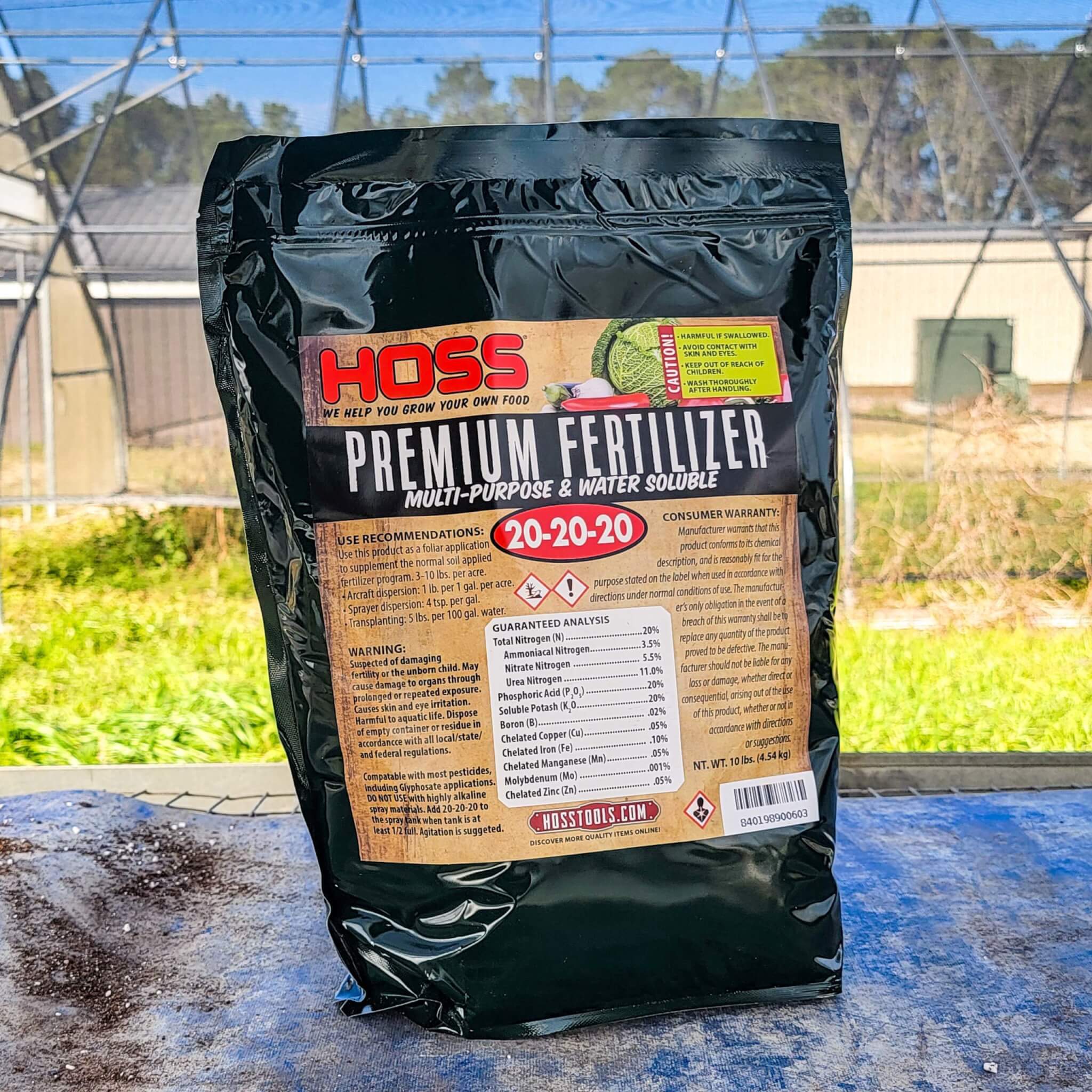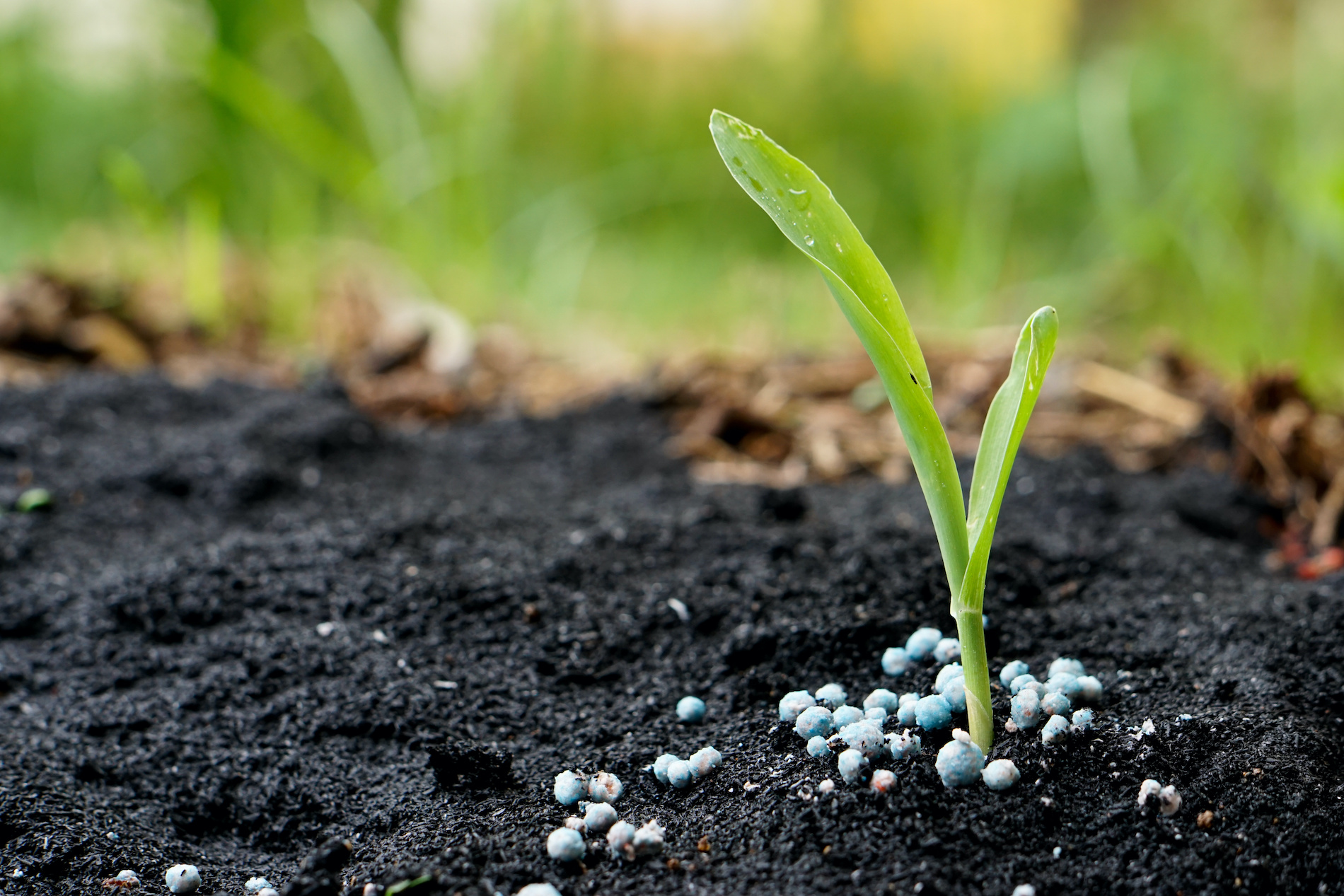

Articles
What Does 20 20 20 Fertilizer Mean?
Modified: October 21, 2024
Learn all about 20-20-20 fertilizer and its significance in articles exploring the benefits, usage, and composition of this popular plant nutrient solution.
(Many of the links in this article redirect to a specific reviewed product. Your purchase of these products through affiliate links helps to generate commission for Storables.com, at no extra cost. Learn more)
Introduction
Welcome to the world of gardening and fertilizers! If you’ve recently embarked on your gardening journey, you may have come across the term “20-20-20 fertilizer.” But what does it mean? And how can it benefit your plants?
Understanding the intricacies of fertilizers and their varying compositions can be overwhelming for beginners. However, with a little bit of knowledge, you can unlock the secret to healthy and thriving plants. In this article, we will delve into the world of 20-20-20 fertilizer and explore its meaning, benefits, application methods, and potential drawbacks.
Whether you have a green thumb or are just starting out, having a basic understanding of fertilizers can go a long way in nurturing your plants. Let’s begin our journey by unraveling the mystery of 20-20-20 fertilizer.
Key Takeaways:
- 20-20-20 fertilizer provides a balanced nutrient supply, promoting healthy foliage, strong roots, vibrant flowers, and increased plant resilience. Its versatility makes it suitable for a wide range of plants, both indoors and outdoors.
- While 20-20-20 fertilizer offers numerous benefits, it’s important to consider factors such as plant type, growth stage, soil conditions, and environmental impact. Responsible usage and sustainable gardening practices can mitigate potential drawbacks.
Read more: What Does Fertilizer Mean
What is 20-20-20 fertilizer?
20-20-20 fertilizer is a type of balanced, water-soluble fertilizer that is commonly used in gardening and agriculture. The numbers “20-20-20” refer to the percentage by weight of three essential nutrients: nitrogen (N), phosphorus (P), and potassium (K) respectively.
Nitrogen is responsible for promoting healthy leaf and stem growth, while phosphorus supports the development of strong roots and flowers. Potassium, on the other hand, aids in overall plant health and resilience, helping plants withstand stress and disease.
The balanced NPK ratio of 20-20-20 means that the fertilizer contains an equal percentage of each nutrient, providing a well-rounded blend for plant growth. This makes it suitable for a wide range of plants and applications, including vegetables, flowers, shrubs, and lawns.
It is important to note that 20-20-20 fertilizer is classified as a complete fertilizer since it contains all three essential nutrients. This makes it ideal for plants with balanced nutritional requirements. However, it may not be the best choice for plants that have specific nutrient preferences or deficiencies.
One of the key advantages of 20-20-20 fertilizer is its versatility. Whether you’re cultivating houseplants or tending to your garden, this fertilizer can be applied to various plant types and growth stages. It can be used for seedlings, transplants, established plants, and even as a foliar spray.
Now that we have a basic understanding of what 20-20-20 fertilizer is, let’s explore the benefits it offers for your plants.
Understanding the NPK ratio
When it comes to fertilizers, the NPK ratio plays a crucial role in determining the nutrient composition and its effect on plant growth. The NPK ratio is a set of three numbers separated by hyphens, such as 20-20-20.
The first number represents the percentage by weight of nitrogen (N), the second number represents phosphorus (P), and the third number represents potassium (K). These three nutrients are known as macronutrients because plants require them in large quantities.
The NPK ratio is essential because it provides valuable information about the proportions of nutrients present in a particular fertilizer. For example, a fertilizer with a ratio of 10-10-10 means it provides an equal amount of nitrogen, phosphorus, and potassium.
Now, let’s take a closer look at each nutrient and its role in plant growth:
- Nitrogen (N): Nitrogen is essential for the development of lush, green foliage. It promotes vigorous leaf and stem growth, enhances photosynthesis, and aids in the production of proteins and enzymes. Nitrogen deficiency can result in stunted growth, pale leaves, and overall poor plant health.
- Phosphorus (P): Phosphorus is crucial for root development, flower formation, and fruit production. It plays a vital role in energy transfer, DNA synthesis, and cellular division. Adequate phosphorus levels promote strong root systems, vibrant flowers, and healthy fruit development. Without sufficient phosphorus, plants may suffer from weak roots, delayed flowering, and reduced yield.
- Potassium (K): Potassium is responsible for various physiological processes in plants, including regulating water uptake, improving disease resistance, and enhancing overall plant vigor. It helps plants withstand environmental stress, such as drought, heat, and cold. Potassium deficiency leads to weak stems, yellowing leaves, and decreased plant resilience.
It’s important to note that different plants have varying nutrient requirements. Some plants may require higher nitrogen levels for leafy growth, while others may need more phosphorus to promote flowering and fruiting. Understanding the specific needs of your plants will guide you in choosing the appropriate fertilizer with the right NPK ratio.
Next, let’s explore the benefits that 20-20-20 fertilizer provides for your plants and overall garden health.
Benefits of using 20-20-20 fertilizer
Using 20-20-20 fertilizer can offer several notable benefits for your plants and contribute to overall garden health. Here are some key advantages of incorporating this fertilizer into your gardening routine:
1. Balanced nutrient supply:
With its equal ratio of nitrogen, phosphorus, and potassium, 20-20-20 fertilizer provides a balanced nutrient supply to your plants. This helps ensure that all essential nutrients are available in the right proportions, promoting healthy growth and development.
Read more: What Does R20 Zoning Mean
2. Enhanced foliar growth:
The nitrogen content in 20-20-20 fertilizer stimulates robust leaf growth and vibrant foliage. This can be particularly beneficial for plants that require lush green leaves, such as ornamental plants, leafy greens, and lawns.
3. Strong root development:
The phosphorus component of 20-20-20 fertilizer supports the development of strong root systems. It encourages root elongation, branching, and increases the plant’s ability to absorb water and nutrients from the soil. This is crucial for overall plant health and nutrient uptake.
4. Improved flowering and fruiting:
Phosphorus and potassium, present in the 20-20-20 fertilizer, play vital roles in flower and fruit production. These nutrients promote the formation of buds, enhance flower color and fragrance, and contribute to higher fruit yields. Using 20-20-20 fertilizer can result in more abundant and visually appealing flowers and fruits.
5. Increased plant resilience:
Potassium, known as the “quality nutrient,” strengthens plants’ overall health and resilience. It aids in disease resistance, drought tolerance, and cold hardiness. By supplying adequate potassium, 20-20-20 fertilizer helps plants withstand environmental stressors and enhances their ability to thrive.
Read more: What Does F20 Mean On A Whirlpool Washer
6. Versatility:
Whether you have a diverse garden with different plant types or a specific variety that requires balanced nutrition, 20-20-20 fertilizer offers versatility. It can be used for various plants, including vegetables, flowers, shrubs, and trees, making it a convenient all-purpose fertilizer for different gardening needs.
By incorporating 20-20-20 fertilizer into your gardening routine, you can provide your plants with the essential nutrients they need for healthy growth, increased flower and fruit production, and improved overall garden vitality.
Now that we’ve explored the benefits of 20-20-20 fertilizer, let’s move on to understanding the factors to consider when using this fertilizer effectively.
Factors to consider when using 20-20-20 fertilizer
While 20-20-20 fertilizer offers numerous benefits for your plants, it’s essential to consider several factors to ensure its effective and appropriate use. Taking these factors into account will help you optimize the benefits of this fertilizer and avoid any potential issues. Here are some key factors to consider:
1. Plant Type and Nutrient Needs:
Different plants have varying nutrient requirements. Before using 20-20-20 fertilizer, consider the specific needs of your plants. Some plants may prefer higher nitrogen levels for leafy growth, while others may require more phosphorus and potassium for flowering and fruiting. Understanding your plants’ nutrient preferences will guide you in choosing the right fertilizer or adjusting the application rate accordingly.
2. Growth Stage:
The growth stage of your plants is an important consideration when using 20-20-20 fertilizer. Seedlings and young plants may require a lower concentration or a diluted application to prevent over-fertilization. Established plants may benefit from regular feedings throughout the growing season. Adjusting the application frequency and concentration based on the growth stage will ensure optimal nutrient uptake and plant health.
Read also: 10 Amazing 20-20-20 Fertilizer for 2025
3. Soil Conditions:
The condition of your soil plays a crucial role in nutrient availability to plants. Before applying 20-20-20 fertilizer, test your soil to determine its pH level and nutrient content. Some soils may already contain sufficient nutrients, while others may require additional supplementation. Adjusting the fertilizer application based on soil test results will prevent nutrient imbalances and maximize the effectiveness of the fertilizer.
4. Environmental Factors:
Environmental conditions, such as temperature, sunlight, and rainfall, can impact the nutrient requirements of plants. During periods of high heat or excessive rainfall, plants may have different nutrient uptake rates. Adjusting the application rate and frequency of 20-20-20 fertilizer according to these environmental factors will help maintain a balanced nutritional supply and prevent nutrient leaching or deficiencies.
5. Proper Application Techniques:
Using the correct application technique is crucial for the effective utilization of 20-20-20 fertilizer. Follow the instructions provided by the manufacturer for the recommended application rate and method. It is generally applied as a liquid fertilizer, mixed with water, and then evenly distributed around the base of the plant. Avoid over-application, as it can lead to nutrient imbalances, burn the roots, or harm the plants.
6. Maintenance and Monitoring:
Regular maintenance and monitoring are essential to gauge the performance of 20-20-20 fertilizer. Keep an eye on the overall health and growth of your plants, observe any signs of nutrient deficiencies or excesses, and make adjustments if necessary. Monitoring also includes checking for any potential fertilizer buildup in the soil, which can occur over time. Flush the soil occasionally or follow a proper fertilization schedule to prevent accumulation.
Considering these factors will ensure that you effectively use 20-20-20 fertilizer to meet the specific needs of your plants, avoid nutrient imbalances or deficiencies, and promote healthy and vibrant growth.
Next, let’s explore the various application methods for 20-20-20 fertilizer.
Application methods for 20-20-20 fertilizer
When it comes to applying 20-20-20 fertilizer, there are several methods you can choose from. The application method you select will depend on the type of plant, its growth stage, and your personal preference. Here are some common application methods for using 20-20-20 fertilizer:
1. Watering Can or Sprayer:
The most common method of applying 20-20-20 fertilizer is by using a watering can or sprayer. Dissolve the required amount of fertilizer in water according to the manufacturer’s instructions. Then, evenly pour or spray the solution around the base of the plant, ensuring that the root area is thoroughly covered. This method allows for easy control over the amount of fertilizer applied and is suitable for both indoor and outdoor plants.
2. Foliar Spray:
An alternative method is applying 20-20-20 fertilizer as a foliar spray. Dilute the fertilizer in water and spray it directly onto the leaves of the plant. This method allows for quick nutrient absorption through the leaves and can be particularly beneficial for plants with nutrient deficiencies or poor root systems. However, be cautious not to spray during hot or sunny periods to avoid leaf burn.
3. Drenching:
Drenching is a method used for plants that require a larger volume of fertilizer or have extensive root systems. Mix the specified amount of 20-20-20 fertilizer with water and carefully pour it around the entire root zone of the plant. This method ensures that the fertilizer reaches the deeper root levels and provides a thorough nutrient supply to the entire plant.
Read also: 11 Best Peters 20-20-20 Fertilizer for 2025
4. Incorporation into the Soil:
For certain plants, especially those growing in containers or raised beds, you can incorporate 20-20-20 fertilizer into the soil before planting. Mix the required amount of fertilizer into the soil to ensure an even distribution of nutrients throughout the root zone. This method provides an extended release of nutrients to the plants over time.
5. Slow-Release Fertilizer:
If you prefer a longer-lasting nutrient supply, you can opt for slow-release 20-20-20 fertilizer. These fertilizers come in the form of granules or pellets, and they gradually release nutrients over an extended period of time. Simply spread the slow-release fertilizer around the plants, following the package instructions for application rates.
Regardless of the application method you choose, it’s important to follow the recommended application rates and frequency as specified by the fertilizer manufacturer. Avoid over-fertilizing, as it can lead to nutrient imbalances, plant burn, or environmental pollution.
Now that we’ve discussed various application methods, let’s move on to explore the potential drawbacks of using 20-20-20 fertilizer.
Potential drawbacks of using 20-20-20 fertilizer
While 20-20-20 fertilizer offers numerous benefits for plant growth and development, there are a few potential drawbacks that gardeners should be aware of. Understanding these drawbacks will help you make informed decisions about the use of 20-20-20 fertilizer in your gardening practices. Here are some potential drawbacks:
1. Imbalanced Nutrient Ratios:
Although 20-20-20 fertilizer provides a balanced ratio of nutrients, it may not address specific nutrient deficiencies in your soil. Different plants have distinct nutrient requirements, and a one-size-fits-all approach may not always meet their needs. Conducting a soil test can help identify any deficiencies or excesses, allowing you to tailor your fertilizer to the specific requirements of your plants.
Read more: What Does Faucet Mean
2. Nitrogen Leaching:
High nitrogen levels in 20-20-20 fertilizer can lead to potential nitrogen leaching. Nitrogen is a highly soluble nutrient that can easily wash away with excessive watering or heavy rainfall. This can result in nutrient runoff, which not only wastes fertilizer but also contributes to water pollution. To minimize nitrogen leaching, follow proper watering practices and avoid over-application of fertilizer.
3. Environmental Impact:
The use of synthetic fertilizers, including 20-20-20 fertilizer, can have environmental implications. Excessive or improper use of fertilizers can contribute to water pollution, as nutrients can run off into nearby water bodies. It’s important to use fertilizers judiciously, following recommended application rates, and consider eco-friendly alternatives, such as organic or slow-release fertilizers, to minimize the environmental impact.
4. Fertilizer Dependency:
Regular use of 20-20-20 fertilizer can potentially lead to a dependency on external nutrient sources. Over time, plants may become accustomed to a constant supply of readily available nutrients, which can negatively impact their ability to absorb nutrients naturally from the soil. To mitigate this, consider incorporating organic matter and practicing sustainable gardening methods to improve the soil fertility, reducing the reliance on synthetic fertilizers.
5. Cost:
Another consideration is the cost associated with using 20-20-20 fertilizer. Synthetic fertilizers, including balanced formulations like 20-20-20, can be more expensive compared to other options. If cost is a concern, explore alternative fertilizers, such as compost or homemade organic fertilizers, which can provide similar benefits at a lower cost or even for free.
While these drawbacks should be taken into account, they can be mitigated by practicing responsible and informed fertilizer use. By following proper application rates, considering alternative fertilizer options, and adopting sustainable gardening practices, you can minimize the potential drawbacks associated with using 20-20-20 fertilizer.
Now that we’ve explored the possible drawbacks, let’s address some frequently asked questions about 20-20-20 fertilizer.
Read more: What Does Chandelier Mean
Frequently Asked Questions about 20-20-20 Fertilizer
Q: Can I use 20-20-20 fertilizer for all types of plants?
A: Yes, 20-20-20 fertilizer is suitable for a wide range of plants, including vegetables, flowers, shrubs, and lawns. However, it’s important to consider specific nutrient requirements and adjust the application rate accordingly.
Q: How often should I apply 20-20-20 fertilizer?
A: The frequency of application depends on various factors such as plant type, growth stage, and soil conditions. As a general guideline, applying 20-20-20 fertilizer every 2-4 weeks during the growing season is recommended. Adjusting the frequency based on plant response and following the manufacturer’s instructions is crucial.
Q: Can I mix 20-20-20 fertilizer with other fertilizers?
A: It’s generally advisable to avoid mixing 20-20-20 fertilizer with other fertilizers unless specified by the manufacturer. Different fertilizers may have varying nutrient compositions and application rates, which can lead to nutrient imbalances or even harmful effects on plants.
Q: Is 20-20-20 fertilizer safe for pets and children?
A: While 20-20-20 fertilizer is generally safe when used as directed, it’s important to keep pets and children away from freshly applied fertilizer. Allow sufficient time for the fertilizer to be absorbed or diluted before allowing access to the treated area. Follow all safety precautions mentioned on the fertilizer packaging.
Q: Can I use 20-20-20 fertilizer on my indoor plants?
A: Yes, 20-20-20 fertilizer can be used for indoor plants. It’s important to follow the recommended application rates and dilute the fertilizer properly to avoid over-fertilization. Indoor plants may require less frequent applications compared to outdoor plants, so adjust the frequency accordingly.
Q: Can I use 20-20-20 fertilizer during the winter months?
A: It’s generally recommended to reduce or halt fertilization during the dormant winter months. Plants have lower nutrient requirements during this period, and applying fertilizer may not be beneficial. Resume fertilization in early spring when plants begin their active growth phase.
Q: Can I use 20-20-20 fertilizer for organic gardening?
A: No, 20-20-20 fertilizer is typically not considered organic as it is a synthetic fertilizer. If you prefer to follow organic gardening practices, look for organic-certified fertilizers that meet the requirements of organic gardening standards.
Remember, these answers are general guidelines, and it’s important to take into account the specific needs and conditions of your plants. If you have any doubts or specific concerns, consult with a local gardening expert or extension service for personalized advice.
Now that we’ve answered some common questions, let’s wrap up our discussion.
Conclusion
20-20-20 fertilizer is a balanced, water-soluble fertilizer that offers numerous benefits for plant growth and development. With its equal ratio of nitrogen, phosphorus, and potassium, this fertilizer provides a well-rounded blend of nutrients, promoting healthy foliage, strong root systems, and vibrant flowers and fruits.
By using 20-20-20 fertilizer, you can supply your plants with the essential nutrients they need for optimal growth and increased resilience. The versatility of this fertilizer allows for its application to a wide range of plants, making it a convenient choice for both indoor and outdoor gardening.
However, it’s important to consider certain factors when using 20-20-20 fertilizer. Factors such as plant type, growth stage, soil conditions, and environmental factors should be taken into account to ensure the appropriate and effective use of the fertilizer. Responsible usage will help prevent nutrient imbalances, minimize environmental impact, and promote sustainable gardening practices.
While 20-20-20 fertilizer provides numerous benefits, it’s also important to be aware of potential drawbacks. Imbalanced nutrient ratios, nitrogen leaching, environmental impact, fertilizer dependency, and cost are some factors to consider when using this fertilizer. By being mindful of these drawbacks and adopting sustainable gardening practices, you can mitigate their potential impacts.
Remember to follow the recommended application rates, choose suitable application methods, and practice regular monitoring and maintenance of your plants. By doing so, you can ensure the optimal and effective utilization of 20-20-20 fertilizer for your gardening needs.
Whether you’re a seasoned gardener or just starting out, understanding the importance of fertilizers and their role in plant nutrition is key to achieving healthy and thriving plants. So, go ahead and give your plants the nourishment they need with the help of 20-20-20 fertilizer, and enjoy the beauty and rewards of a flourishing garden.
Frequently Asked Questions about What Does 20 20 20 Fertilizer Mean?
Was this page helpful?
At Storables.com, we guarantee accurate and reliable information. Our content, validated by Expert Board Contributors, is crafted following stringent Editorial Policies. We're committed to providing you with well-researched, expert-backed insights for all your informational needs.









0 thoughts on “What Does 20 20 20 Fertilizer Mean?”